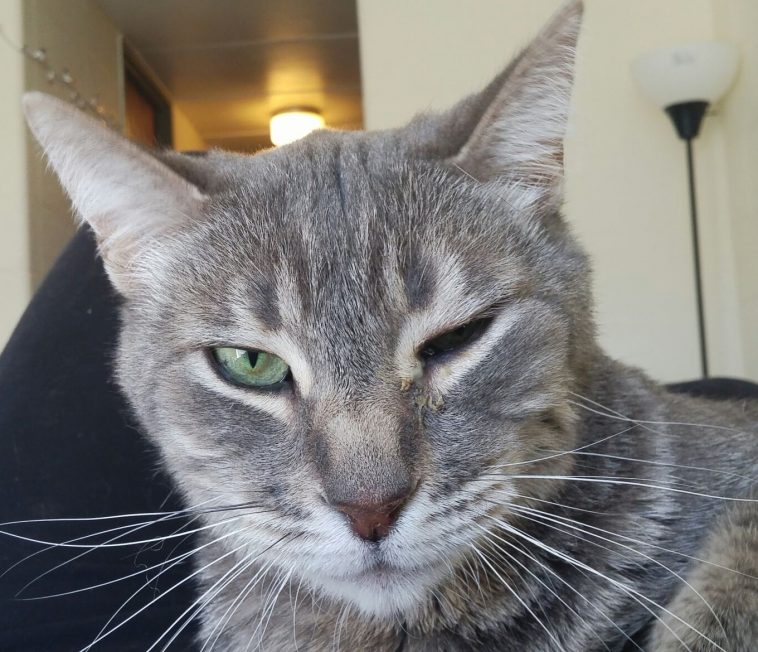
Structures associated with the cat’s eye. The conjunctiva is the mucous membrane lining the eyelids and part of the eyeball. We usually call the nictitating membrane the third eyelid.
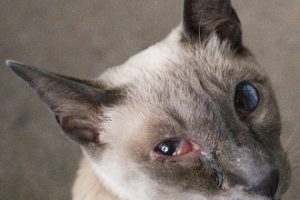
When the third eyelid covers the eyes partially, this is an indication that something is wrong with the eye. This may look like your cat is squinting one eye.
Cat Is Squinting One Eye… What Are the Causes?
Blepharitis and Conjunctivitis
This is the inflammation of the eyelids and the conjunctival membranes that line the eyelids, respectively. In these conditions, the eyelids and the margins of the eyelids become swollen and the cat will look like it is squinting.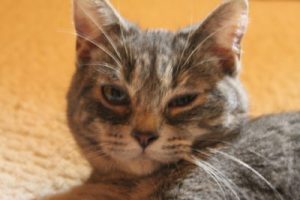
In the condition called blepharitis, it is the eyelid that is swollen giving the appearance that the cat is squinting one eye.
Blepharospasm
This is defined as the involuntary closure of the eyelids, hence squinting. The condition usually starts with rapid eye blinking and later the eyelids will close. It is a sign that something is wrong with the eye or eyelid — usually an infection or injury, much the same as those already mentioned above. Painful conditions affect the free nerve endings in the cornea and conjunctival membranes and cause blepharospasm.
Blepharospasm is the involuntary closure of the eyelids usually caused by painful conditions which affects the free nerve endings.
Symblepharon
This is the adhesion of conjunctival tissue to another conjunctival surface or to the cornea usually seen in feline herpesvirus infection especially in kittens 10 days to 3 weeks old. The eyes are almost glued together by the discharge making it look like the kitten is squinting the affected eye.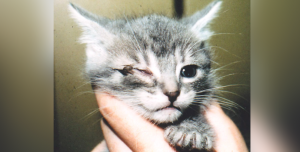
In symblepharon, the excessive eye discharges almost glue together the eyelids. This is commonly seen in kittens with feline herpesvirus infection.
Infections of the Upper Respiratory Tract
We generally call this group of diseases Influenza, Cat Flu, or Viral Rhinitis. Viral upper respiratory tract diseases are self-limiting but bacteria, like Bordetella bronchiseptica, Chlamydophila felis and Mycoplasma, can complicate them and result in a more serious disease.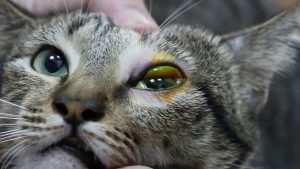
Infectious diseases of the upper respiratory tract caused by viruses and bacteria cause conjunctivitis.
Keratoconjunctivitis sicca
This is the chronic inflammation of the cornea and surrounding conjunctival tissues due to being constantly dry because of decreased tear production. Tears are necessary to remove debris and infectious agents from the eye. When there is little or no tear formation, eye irritation is constant and the cat will squint. Keratoconjunctivitis sicca commonly arrives due to immune-mediated damage to the tear-producing glands or herpes virus infection.Anisocoria
This is a condition wherein the pupils of the cat’s eyes are not of the same size. This may indicate corneal injury, the central nervous system (CNS) or peripheral nerve problems, glaucoma, or inflammation in the interior of the eye. The eyelid of affected eye is droopy and the cat is often squinting or rubbing the eye.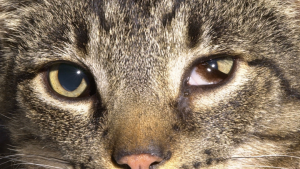
In anisocoria the pupils are not of the same size, the eyelid of the affected eye is often droopy, hence the cat is squinting one eye.
Other Conditions
Any eye condition that causes sensitivity to light or photophobia can result in squinting. Diseases affecting some of the cranial nerves may result in facial paralysis causing droopy eyelids which appears like squinting.What To Do When the Cat Is Squinting One Eye
The eye is a very delicate organ. Only a trained veterinarian can perform a thorough physical examination of the eyes. When you see that your cat is squinting one eye, or even both eyes, it is best to make an appointment for a veterinary office visit immediately. The problem must be diagnosed properly at the soonest possible time and treatment started early. Simple conditions like a shallow scratch on the cornea can get infected and complicated. Eye problems left unresolved for a prolonged period of time may result in permanent eye damage and blindness. Viral respiratory infections may complicate to pneumonia. Do not force the eyelids open on your own because you may only aggravate the injury. Sometimes he may need a sedative or pain reliever first, especially in cases of traumatic injury. Do not attempt to give pain relievers orally at home using over-the-counter human pain medicines because they may be toxic and fatal to cats.Home Care
At home, the first thing to do is to prevent further self-trauma to the irritated eye by putting an Elizabeth collar on your cat. Keep the cat comfortable by turning down bright lights or place the cat in a dimly lit room. Apart from obvious traumatic injuries, it is better to assume that whatever is causing the inflammation of the eyes may be contagious. Therefore isolate the cat from other cats in a multi-cat household. Proper home care is essential to keep the cat comfortable and less likely to keep trying to scratch the irritated eye. Gently wipe away eye discharges with a warm damp cloth. Start wiping from the corner near the nose working outwards to move debris away from the eyes. When the eyes are cleared of dried up discharges, you may place over it a sterile pad soaked in cold water to help soothe the irritation. In case of chemical irritants, you may flush the eyes with artificial tears. Do not use tweezers on the eyes. If you need to remove a foreign object from the eye, you may use a cotton swab and do it gently. Nursing care at home is important especially feeding. A cat that is sick will not have an appetite to eat but must have nourishment so that the immune system can fight back infections. Your veterinarian can give you advice on home-feeding sick felines.Prevention of Eye Problems
Vaccination is of prime importance to protect your cat against the respiratory viruses – feline herpesvirus and feline calicivirus.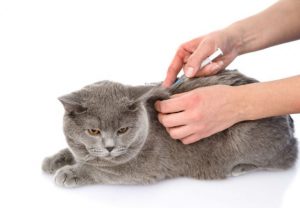
Have your cat vaccinated to protect them against the common viral causes of upper respiratory diseases?
If you are concerned about your cat’s well-being, you can prevent the most common feline health problems by making sure your cats stay well hydrated.

Simba and Skipper prefer different drinking spots. Owner Laura is happy about the increased water intake of their cats!

